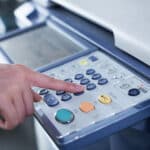
Before Seeking Out a Print Services Provider
The world of business has changed in recent years, from a digital-friendly one to a digital-dependent one. Companies who previously maintained their own servers and prohibited equipment from leaving the workplace are now faced with evidence that their workers operate equally as efficiently and securely at home.
Despite the fact that information is increasingly digital, one thing businesses are discovering to be even more unexpected – employees’ continued reliance on print. The average employee uses around 10,000 pieces of paper each year. That’s about 34 pages every day. Many organizations are seeking out professional print solutions as a resource in response to the unforeseen demand for printing. Here are three things any company should think about before hiring a printer.
What are the business’s goals for print?
Every business has distinct goals for improving its existing printing operations. The company’s objectives may also have an influence on the programs and types of printer service providers that are most suitable.
Many organizations are attempting to save money on their existing printer settings. Many print services vendors provide programs that can help you accomplish this. This might include providing greater pricing or efficiency for printer ink or toner, as well as consolidating a multi-printer office by using a higher-function printer with bigger print potential. It may also be as simple as cutting IT time and expenses to keep printers up to date and running smoothly.
But it’s not always about saving money. Printer service providers assist businesses in becoming greener, monitoring printer usage, and configuring applications to match the demands of individual offices, departments, and workers. Print services providers may also provide monitoring, security, service, and supplies for several locations throughout a company’s new presence.
What Are the Current Faults, Issues, And Risks?
Knowing exactly what is wrong with your current print setup will aid you in choosing the finest printer partner and assisting that business in determining the best equipment and program to provide.
The printers themselves are one of the most common print flaws that businesses face. This is especially true in recent years when print was regarded as less important than simply expediting business as quickly as possible. Unfortunately, many firms are now dealing with ancient printers or devices that no longer meet contemporary office demands, thanks to this attitude.
It’s critical to thoroughly analyze the machine(s) and document how often they must be loaded with paper, ink, or toner. How many times during a day does someone run into a paper jam? How long do print jobs take in production line queues? Perhaps most significantly, how much time is the equipment out of order or being serviced? All of these are crucial questions to comprehend and address.
Security, particularly in this political environment, is at least as crucial as general equipment health. And like with laptops and other connected devices, printers that are not secured with firewalls, whitelists, VPNs, or other security measures have shown to be a potential security hazard. As a result, assessing the current security state and precautions is critical for appreciating where printer protection fits into the picture.
Finally, the way a firm utilizes printing has a considerable influence on the services that may help to boost company performance while reducing expenses. A small business with one or two large printers that seldom prints is nearly as harmful as a firm with numerous smaller printers that cannot keep up with demand. In either case, there’s a danger of missing revenue. Unused printers will accumulate dust and gunk, which may cause them to function improperly. Smaller capacity printers in a print-heavy workplace, on the other hand, might slow down production by using slower printing processes, higher paper usage, or additional breakdowns as a result of wear and tear.
Research Options
If you’re looking for printer service, it’s vital to research and comprehend all the various office printer service alternatives. For example, privately owned and operated printers may still be an attractive choice. This is especially appealing to organizations that are comfortable devoting IT resources to printer maintenance.
Another smart alternative is printer leasing. This approach is particularly appealing for firms who don’t want to cover the cost of one or more high-function printers up front. Even better, most printer leasing partners can add service and maintenance contracts to aid with ongoing cleaning and maintenance costs. Because most printer leases include provisions to either buy out or upgrade to a newer machine if the lease expires, these contracts are especially useful when equipment ages.
The best way for businesses to cut overhead is to hand off all printing operations (MPS), as it were. MPS providers reduce the cost, security, management, and maintenance of machines down to a single provider and monthly expenditure. They also assist in eliminating printer-related help desk calls from IT.
Finding a trustworthy partner is a significant step when it comes to obtaining an office printer solution. It’s critical to research all of the possible solutions, understand current problems and risks, and evaluate everything against present business goals before diving in with both feet. Businesses that take these three steps will be better armed to make the best printer service decisions for their company’s future success.





